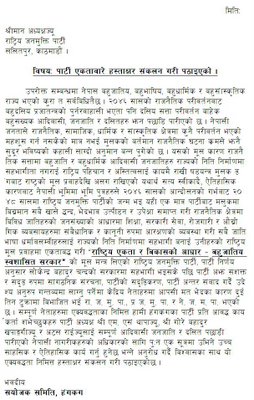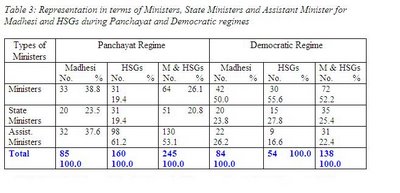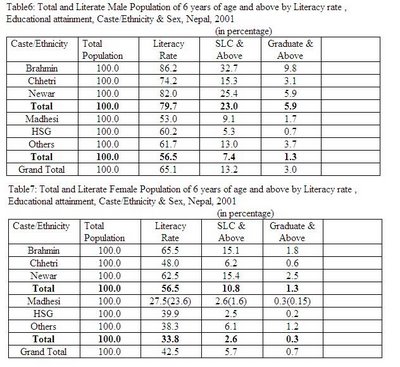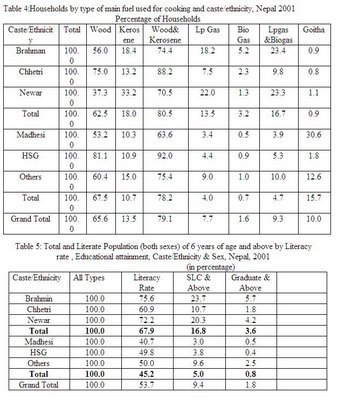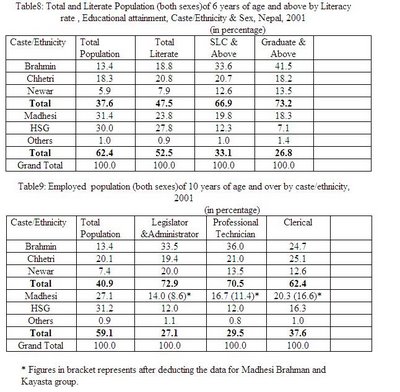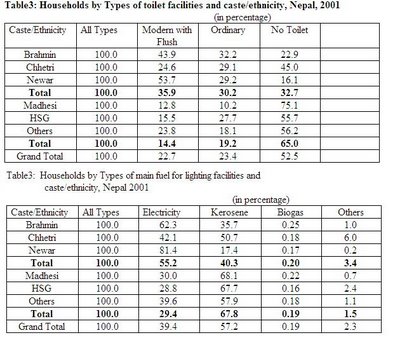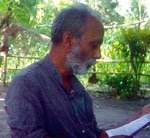

जनतान्त्रिक विरुद्ध माओवादीको युद्ध घोषणा माओवादीले गरेको वार्ताको अनुरोध किन अस्वीकार गरेको भन्ने प्रश्नमा तराई जनतान्त्रिक मुक्ति मोर्चाका संयोजक जयकृष्ण गोइत भन्छन्, “एकातिर हाम्रा नेता–कार्यकर्ताको हत्या गर्ने, अर्कोतिर वार्ताको कुरा पनि गर्ने? त्यसमा पनि वार्ता त सरकारसँग पो गर्ने हो। माओवादीसँग त समझदारीसम्म हुनसक्छ।” सरकारले बोलाए वार्तामा बस्ने बताउने गोइतको आफ्नै गुनासो छ। उनी भन्छन्, “हामी त वार्ता गर्न तयार छौँ। तर सरकार १२ वर्षसम्म हतियार उठाएको पार्टीसँग कुरा गर्छ, हामीसँग गर्दैन। यो तराईवासीप्रति भेदभाव हो।”If the Maoists think the JTMM are a tough nut to crack, they should know how the seven parties have been feeling for the past 10 years. The JTMM is acting irrational and violent. They don't seem to have a clear political program. Is it autonomy for the Terai, or what?
The Maoists should not treat the JTMM as their internal problem. Instead the seven party alliance should reach out to the JTMM just like they reached out to the Maoists.
We are lucky there are not many more splinter Maoist groups. Imagine what if Prachanda and Baburam had gone their separate ways.
The idea has to be to make an attempt to open up a channel of communication with the JTMM. Let them make public their political agenda. And let's work to convince them they should use the constituent assembly to achieve their goals.
This JTMM problem could easily get worse. It could easily get widespread. It could make bad the Pahadi-Madhesi dynamic in the Terai. The economic migration of Nepalis from the hills to the Terai will only continue. And that is okay. A Nepali citizen can move to any part of the country. But this violence will poison the communal sentiments on the ground. We can not allow that.
So we have to get politically proactive. The seven party leaders should issue direct statements inviting Ram Krishna Goit to use the constituent assembly to address the grievances of the Terai communities. He should be offered a conditional amnesty so he can safeland into the mainstream.
We have done it before with the Maoists. We can do it again with the JTMM. And I urge the Maoist leaders to exercise restraint. Violence is not the solution to the JTMM nuisance. The solution is proactive political action.
Matrika Yadav has to take the lead on this one. He has to realize an open warfare between these two armed groups could have serious negative repurcussions for the peace process underway. We don't want that.
तराईमा मारामार मुलुक स्थायी शान्तिको दिशातर्फ अग्रसर भइ र हँदा तराईमा भने माओवादी र जनतान्त्रिक तराई मुक्तिमोर्चाबीच मारामार चलेको छ ..... १० वर्षको 'जनयुद्ध' मा समेत नदेखिएको द्वन्द्व यतिबेला सिराहा र सप्तरीवासी भोग्दैछन् । साउन ४ गते राती मोर्चाका पोलिटव्युरो सदस्य रामविलाश यादवको सिराहा जिल्लाको सन्हैठास्थित घरलाई लक्षित गरी घेराबन्दीसहित 'कारबाही' गरे । यादव नभेटेपछि गाउँका एक दर्जन सर्वसाधारणलाई कुटपिट गर्नुका साथै त्यहाँबाट दुई लाख नगद, गरगहनासमेत माओवादीहरूले लुटपाट गरेका छन् । सो कारबाहीमा माओवादीहरूले स्थानीय ७० वषर्ीया वृद्धदेखि १० वषर्ीय बालकसम्म्ालाई छाडेनन् । घटनाको सर्वत्र निन्दा भए पनि माओवादीका जनकपुर-सगरमाथा व्युरो सदस्य दिनकरले मोर्चाविरुद्धको नियमित र घोषित अभियानअन्तर्गतको कारबाही भनी प्रतिक्रिया दिए । .... मोर्चाविरुद्ध 'युद्ध' को घोषणा गर्दै माओवादीका मधेशी फाँटका नेता मातृका यादवले मोर्चाका संयोजक जयकृष्ण गोइतलाई दरबार, भारत र अमेरकिाको उक्साहटमा मधेशी आन्दोलनलाई मत्थर पार्न सक्रिय रहेको आरोप लगाएपछि द्वन्द्व चुलिएको हो । यादवद्वारा लगाइएको आरोपको खण्डन गर्दै गोइतले अढाइ सय वर्षदेखि मधेशीलाई शोषण गर्ने पहाडिया ब्राह्मणवाद हावी रहेको माओवादी नेताको दासत्वले मधेश मुक्तिको कुरा गर्न सुहाउँदैन भन्ने प्रतिक्रिया दिएका थिए । ..... कम्युनिष्ट राजनीतिका जानकारहरू गोइतविरुद्ध यादवको आरोप नयाँ नरहेको बताउँछन् । .... मोर्चा माओवादी र तराईमा बसोवास गर्दै आएका पहाडी मूलका बासिन्दाहरूप्रति आक्रामक देखिएको छ । पहाडी मूलका कर्मचारीलाई अपहरण गर्ने र मोटो रकम फिरौती लिएर छाड्ने मोर्चाको दिनचर्या बनेको छ । ..... झन्डै चार दशकदेखि वाम आन्दोलनमा सक्रिय गोइत विभिन्न कम्युनिष्ट गुट हँुदै नेकपा -एमाले)बाट दुईपटक सप्तरीमा संसदीय चुनावमा सहभागी भए । तर, गोइत पार्टीका पहाडे नेता-कार्यकर्तासँगको अन्तरविरोधका कारण अलग्गिएको बताउँछन् । ...... माओवादीमा सामेल कम्युनिष्ट दर्शनका प्रशिक्षक गोइतले माओवादीभित्र पनि उत्तिकै सम्मान पाए । 'आर्थिक, सामरकि र भौगोलिक दृष्टिले महत्त्वपूर्ण मधेश र आदिवासी मधेशीको मुक्तिबिना पूर्णता पाउँदैन' भन्ने ठहर गर्दै ०५८ सालमा माओवादी अध्यक्ष प्रचण्डको उपस्थितिमा सर्लाहीको बरथहवामा सम्पन्न मधेशी सम्मेलनमा गोइतको अध्यक्षतामा मधेशी राष्ट्रिय मुक्तिमोर्चा गठन भयो । ...... माओवादीभित्र मतभेद बढ्दा एकीकृत तराईको विषयमा छलफलै नगरी ०६० असार २६ र २७ गते सम्पन्न मधेशी राष्ट्रिय मुक्तिमोर्चाको प्रथम राष्ट्रिय भेलाबाट आफूलाई अध्यक्षबाट हटाएर मातृका यादवलाई सो जिम्मेवारी दिइएको गोइतको आरोप छ । ०६१ साउन १० गते वक्तव्यमार्फत गोइतले माओवादीबाट आफूलाई अलग गर्दै आफू संयोजक रहेको जनतान्त्रिक तराई मुक्तिमोर्चा गठन गरेको घोषणा गरेका थिए । ..... त्यसबेला माओवादीभित्र प्रभावशाली मानिने सिराहाका देवनारायण यादव, नगेन्द्र पासवान, सुरज, रौतहटका अजय, सर्लाहीका रामकुमार शर्माजस् ता कैयाँै गोइतको मोर्चामा सहभागी थिए । तर, फुटलाई माओवादीले सहजसाथ लिन सकेन । मोर्चा गठन भएको एक वर्ष नबित्दै चार जना पोलिटव्युरो सदस्य भएको मोर्चाका दुई जना मारएि र एक जना पार्टी छाडेर बाहिरएिपछि मोर्चा झस्कियो । मोर्चा गठन भएको १० महिना नबित्दै पाँच जना पोलिटव्युरो सदस्यमध्ये अजय यादव र देवनारायण यादवलाई सेनाले र सुरजलाई माओवादीले हत्या गरेपछि मोर्चा झस् िकनु स् वाभाविकै थियो । ..... गोइतले भारतीय सीमावर्ती क्षेत्रमा चोरी डाँका पेशामा संलग्न तर माओवादी र प्रशासनबाट त्रसित केही व्यक्तिहरूलाई संरक्षण दिएर सशस्त्र गतिविधि बढाइरहेका छन् । मोर्चाका कार्यकर्ताहरूले हालसम्म सुरक्षाकर्मीमाथि कुनै आक्रमण नगरे पनि माओवादीका जिल्लास्तरीय एक दर्जन कार्यकर्ताको हत्या गरसिकेका छन् ।
In The News
Two Maoists shot dead, 16 injured in separate incidents Kantipur Online, Nepal Suspected activists of the Janatantric Terai Mukti Morcha (JTMM) on Wednesday shot two Maoist cadres to death in Saptari. ..... both the victims were local Maoist cadres. ..... JTMM Saptari district “coordinator” Ranabir Shing had threatened to kill the duo. .... The JTMM has killed nine Maoist cadres so far. .... JTMM activists abducted Saptari-based customs officer Tirtha Ram Khatiwada and demanded Rs. 500,000 for his release. .... some 20 people were also injured in a scuffle between two Maoist factions in Dhanusa today. ..... The fight that took place between the Maoists-led by chief of Dhanusha district, Bishnudev Yadav and other Maoist cadres of the Sabaila village is a result of long standing racial rivalry between the Yadavs and other people of the area, reported our correspondent Shyam Sundar Sashi. ...... The racial differences in Terai between the people from the Yadav community and non-Yadavs, who have a majority, are not uncommon.
JTMM Demands Rs 1m For NT Engineers' Release Himalayan Times, Nepal
Maoist leader Yadav declares war against JTMM Kantipur Online, Nepal
JTMM’s Terai Bandh Cripples Life In Siraha Himalayan Times, Nepal
JTMM Releases Rajbiraj Custom Office Chief Himalayan Times, Nepal
JTMM demands One million rupees for release of two engineers ... Nepalnews.com, Nepal
Two Maoist cadres shot at in Siraha PeaceJournalism.com, Nepal
Maoists declare war against breakaway outfit Nepalnews.com, Nepal
Rebels Declare War against Splinter Faction Nepal human Rights News, Nepal
Another Customs Official Abducted In Siraha Himalayan Times, Nepal
Two Maoists shot dead, 16 injured in separate incidents Kantipur Online, Nepal
Two Maoists killed; over a dozen injured in east Nepal Zee News, India
Gang Shoots Dead Two Maoists in Saptari Himalayan Times, Nepal
Maoists Declare War Against JTMM OhmyNews International, South Korea
Rebels Declare War against Splinter Faction Nepal human Rights News, Nepal
Maoists Declare War Against Breakaway Faction Himalayan Times, Nepal
Nepal: "light at end of tunnel" —for tribal peoples too? World War 4 Report, NY
Visitors
| 13:13 | Reliance Infocom Ltd., India |
| 13:20 | State Compensation Insurance Fund, San Francisco, United States |
| 17. | 13:25 | Swipnet, Switzerland | |
| 18. | 13:27 | Trinity College, Hartford, United States | |
| 19. | 13:30 | CTX Mortgage Company, Dallas, United States |
| 13:43 | Terra Networks Chile S.A., Chile |
| 13:51 | Tiscali GmbH, Germany |
| 14:21 | Cisco Systems, Inc., United States |
| 31. | 14:55 | Indiana University, United States | |
| 32. | 14:56 | United States Navy, United States |
| 36. | 15:13 | Uninet Mexico, Mexico | |
| 37. | 15:13 | Northrop Grumman Corporation, Los Angeles, United States | |
| 38. | 15:15 | Bharti British Telecom Internet Limited, India |
| 15:21 | Bharti British Telecom Internet Limited, India |
| 16:30 | Towerstream Corporation, Middletown, United States |




